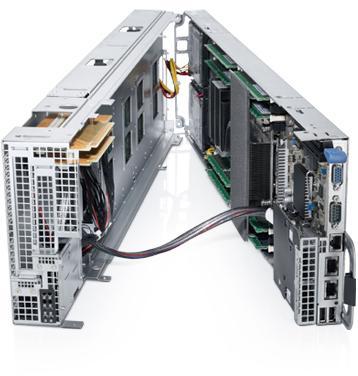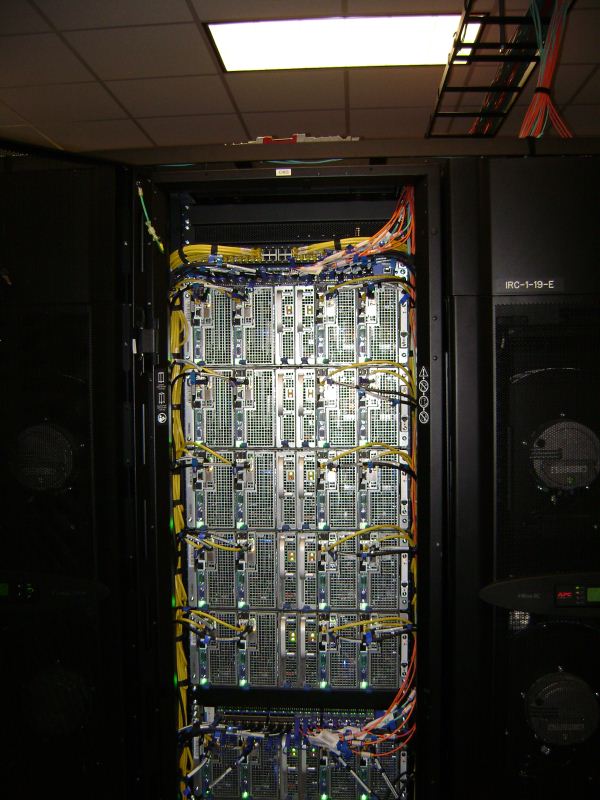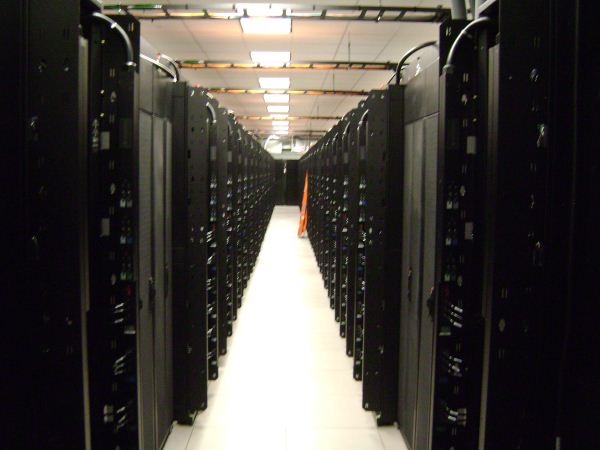The Xeon Phi at work at TACC
by Johan De Gelas on November 14, 2012 1:44 PM EST- Posted in
- Cloud Computing
- CPUs
- IT Computing
- Intel
- Larrabee
- Xeon
- Xeon Phi
We had the chance to briefly visit Stampede, the first Supercomputer based upon the Xeon Phi. This is one of the supercomputers at the Texas Advanced Computing Center (TACC).
Stampede consist of 6400 PowerEdge C8220X and C8220 server Sleds. Typically these servers contain two octal core Xeon E5s, 32 GB of RAM and one GPU/MIC.

Eight of those server sleds find a home inside the C8000 4U Chassis, together with two power sleds.
Dual ported Mellanox ConnectX with FDR infiniband interfaces connects all those servers together to form one large supercomputer. In each rack you can find on 8 C8000s on average.
Connect 200 racks together and you get the Stampede supercomputer:
The Xeon E5s deliver two Petaflops at the moment. When all Xeon Phi are in place, an additional 8 Petaflops will be available to researchers on Stampede.
Intel Xeon Phi is not a standalone replacement to a GPU. For example, the Xeon Phi has no texture units. As a result remote visualization is done by 128 NVIDIA Tesla K20 GPUs. The rest of the supercomputer: 272 TB total memory and 14PB of disk storage. The complete supercomputer and the necessary cooling will require up to 6 megawatts of power.












46 Comments
View All Comments
tipoo - Wednesday, November 14, 2012 - link
I wonder if we'll ever have more numerous smaller cores like these working in conjunction with larger traditional cores. A bit like the PPE and SPEs in the Cell processor, with the more general core offloading what it can to the smaller ones.A5 - Wednesday, November 14, 2012 - link
That's called heterogeneous computing. It's definitely where things are going in the future and you can argue that it's already here with Trinity.nevertell - Wednesday, November 14, 2012 - link
The great thing about the Cell was that both the PPE and the SPEs had access to the same memory. Trinity doesn't and while that may be because there isn't an OS that would take advantage of that, hardware is as capable as software is efficient for that exact hardware solution.There is no need for major parallelism in the consumer space, since nobody is willing to rewrite their programs to run on something faster whilst the general public is already served well enough by a Core i3 or i5.
name99 - Friday, November 16, 2012 - link
"The great thing about the Cell was that both the PPE and the SPEs had access to the same memory."Hmm. This is not a useful statement.
Cell had a ludicrous addressing model that was clearly irrelevant to the real world. It's misleading to say that the cores had access to "the same memory". The way it actually worked was that each core had a local address space (I'm think 12bit wide, but I may be wrong, maybe 14 bits wide) and almost every instruction operated in that local address space. There were a few special purpose instructions that moved data between that local address space and and the global address space. Think of it as like programming with 8086 segments, only you have only one data segment (no ES, no SS), you can't easily swap DS to access another segment, and the segment size is substantially smaller than 64K.
Much as I dislike many things about Intel, more than anyone else they seem to get that hardware that can't be programmed is not especially useful. And so we see them utilizing ideas that are not exactly new (this design, or transactional memory) but shipping them in a form that's a whole lot more useful than what went before.
This will get the haters on all sides riled up, but the fact is --- this is very similar to what Apple does in their space.
dcollins - Wednesday, November 14, 2012 - link
That's exactly how this supercomputer, and all supercomputers offering accelerated compute, work. Xeon or Opteron CPUs handle complex branching tasks like networking and work distribution while the accelerators handle the parallelizable problem solving work.Merging them onto a single die is simply a matter of having enough die space to fit everything while making sure that economics of a single chip is better than separate products.
tipoo - Wednesday, November 14, 2012 - link
*in consumer computing I mean.Gigaplex - Wednesday, November 14, 2012 - link
Both AMD Fusion and Intel Ivy Bridge support this right now. The software just needs to catch up.tipoo - Wednesday, November 14, 2012 - link
Sort of I suppose, but I think something like this would be easier to use for most compute tasks for the reasons the article states, these are still closer to general processor cores than GPU cores are.frostyfiredude - Wednesday, November 14, 2012 - link
Something like ARM's big.LITTLE in a sense seems like a good idea to me. I'm not sure how feasable it is, but having one or two small Atom-like cores paired to larger and more complex Core processing cores all sharing the same L3 sounds like a decent idea for mobile CPUs to cut idle power use. My guess is the two types of cores would need to share the same instructions, so the differences would be things like OoO vs In-order, execution width, designed for low clock speed vs high clock speed. The Atom SoCs can hit power use around that of ARM SoCs, so if Intel can get that kind of super low power use at low loads and ULV i7 performance out of the same chip when stressed that'd be super killer.CharonPDX - Thursday, November 15, 2012 - link
One rumor I had heard upon Larrabee getting cancelled and turned into Knights Ferry was that this technology might be released as a coprocessor that used the same socket as the "main" Xeon.That you could mix-and-match them in one system. If you wanted maximum conventional performance, you put in 8 conventional Xeons. If you wanted maximum stream performance, you'd put in one "boot" conventional Xeon, and 7 of these. (At the time, there were also rumors that Itanium was going to be same-socket-and-platform, which now looks like it will come true.)